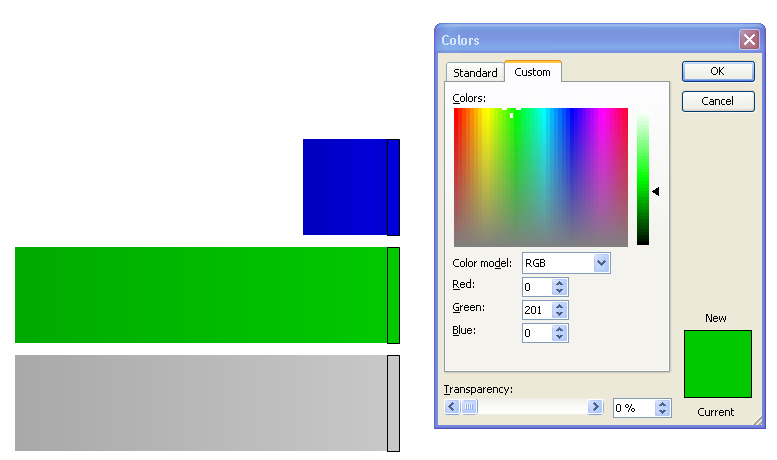What is the smallest amount of change in color that a normal healthy human eye can detect ?
Lets say on a scale from 0-255 (8bit), where 0 is black and 255 is full Green (as the eye is most sensitive to green), then can it detect change in green between values - for example - 138 and 139 ?
I guess 8bit could have been chosen for compatibility and ease of use with digital computing systems, so the dynamic range of 8bit may be more than what the eye can discriminate, but then what is practically the smallest step of color the eye can detect ?
+ Reply to Thread
Results 1 to 9 of 9
-
-
Do you mean side by side or viewed separately? I don't know the answer, but it would seem to me that side by side could be detected to a pretty small difference, but viewed separately, with something else in between would be much harder to identify differences.
"Shut up Wesley!" -- Captain Jean-Luc Picard
Buy My Books -
Most people are off by up to 10 values.
Want my help? Ask here! (not via PM!)
FAQs: Best Blank Discs • Best TBCs • Best VCRs for capture • Restore VHS -
Within the ~16 million colors that can be encoded with 8 bits each of red, green, and blue, you can see the difference between many of the adjacent colors, but not all of them. Can you see the small box of 64,65,64 (R,G,B) near the middle of this 64,64,64 image?

How many of the blocks of successive gray scale values can you differentiate in this image?

I can see the difference between almost all of them.
Exactly which adjacent pairs you can differentiate will vary from monitor to monitor. -
No I can't make out the difference in the first image, but I can count 16 bars in the second image so I guess I can say I see a difference between all of them ?
I think what I am trying to find out what is the middle ground between the first and second image. The point where you are able to detect a color difference.
The second image has 16 bars so the step size between each bar must have been 16 to get a spread from 0(black) to 255(white). In other words, what would be the maximum step size after which you can start seeing each bar distinctly, (and before which you cannot detect the boundaries between adjacent bars). If the step size was 1(one) then you'd see a smooth continous transition from black to white with no visible seperation between intermediate shades.
I did a quick and dirty test, details of which I will post later tonight, but initial results suggest that you can start noticing the boundaries roughly every 3 steps of Green, or every 6 steps of blue, or every 4 steps of red. And that's not a blind test or anything but knowing where the boundary is and where to look for it.
Ofcourse there a few variables like the accuracy and resolution of the color decoder, the monitor, etc.. -
I can see it but I have to look for it. Room lighting makes a difference. It will be more obvious in a dark room.Originally Posted by Movie-Maker
No. Each of the 16 horizontal bars has 16 shades of gray. You should be able to see the transition between most of them.Originally Posted by Movie-Maker
8 bits each of RGB is not enough to prevent visible banding.Originally Posted by Movie-Maker
The intensity in the rows and columns run (24x16 pixel blocks, 16 blocks per row, 16 blocks per column):Originally Posted by Movie-Maker
0 - 15
16 - 31
32 - 47
...
240 - 255
< 1Originally Posted by Movie-Maker
No, you should be able to see most of the single digit transitions in the second image. You have to look closely, of course!Originally Posted by Movie-Maker -
ok here's what I did. Let me know if I am not understanding this but from what I am seeing it seems like 8 bit is more than enough.
See the attached screen shot. In MS Word(sorry no formal graphics tools here), I created a line of rectangular boxes and filled each one of them individually using the color dialog by specifying the RGB values. I have highlighted one such box to give you an idea of the size and shape of the box.
I just used green, gray and blue as examples.
Now for the Green and Gray patches each box's rgb color value is +1 the previous one. So if the RGB value of the first box was (178,178,178), then the next one would be (179,179,179), second (180,180,180) and so forth.
So the difference between the RGB values of adjacent boxes is only 1(one) and the difference between the first and the last box is ~30. Note that even though you can see an obvious and smooth change in shade from one end to the other, you still can't identify the individual boxes.
Now look at the blue patch, the difference in the rgb value between all those boxes is +5. So each one is +5 higher than the previous one. Now you can barely begin to make out the different boxes.
So this tells me that 8 bit would more than enough ? unless I am not understanding something correctly ?
Although if I change the step size to 3 for the gray scale, I can certainly see the individual gray boxes. With a step size of 2 in normal/practical viewing distance and lighting you still can't make them out.

-
Here's a section of the gray bar enlarged 4x:

You can't see the transitions? I can see every one of them.
Similar Threads
-
Detect Scene Change in x264
By Anakin in forum Newbie / General discussionsReplies: 3Last Post: 9th Feb 2012, 20:31 -
How to change background color of my video?
By sanny in forum Newbie / General discussionsReplies: 1Last Post: 22nd Oct 2008, 17:34 -
Change from a color to another in a video
By Nokiamania in forum EditingReplies: 4Last Post: 7th Jul 2008, 02:51 -
How to change the color of the taskbar from black.
By mysts in forum ComputerReplies: 2Last Post: 24th Feb 2008, 15:03 -
ConvertXtoDVD - Can't change subtitles color
By Phil240 in forum Authoring (DVD)Replies: 5Last Post: 8th Dec 2007, 04:03



 Quote
Quote